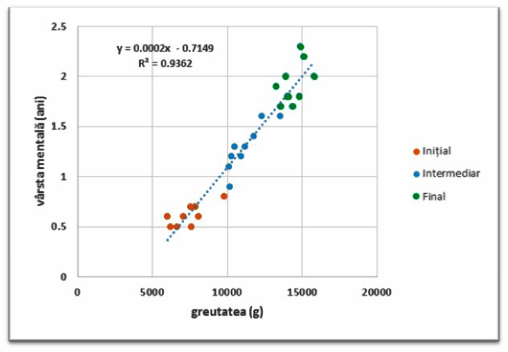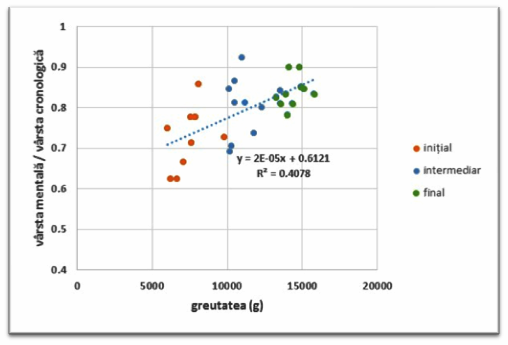Study Regarding the Relation between Chronological Age, Mental Age and Weight of the Premature Included in a Physical Therapy Program
Abstract
A premature is a newborn whose birth weight is equal to or less than 2500 grams. Early identification of these children who may have delays or difficulties through motor assessment and intervention is important in the future. Purpose: To assess the implemented recovery programs by correlating the results of premature infants: mental age, chronological age and weight. Hypothesis: We assume that a customized and adapted physical recovery program leads to favourable neuromotor development of the premature, suitable to chronological age. Material and methods: The study included 10 children born prematurely. They were subjected to Portage Test (calculation of mental age) and weight test. The applied therapeutic program included: exercise, massage, neuromotor rehabilitation methods, hydrotherapy and music therapy. Results and discussion: For Portage Test, we calculated mental age, which was further correlated to children’s weight. A complete development of the two ages is assumed to be equal. In our study, the ratio shows values between 0.625-0.923, with an overall average of 0.791 for the 3step test. Mean values by stage range from 0.729 in the initial stage to 0.803 in the intermediate stage and 0.839 in the final stage. Conclusions: Regression models show that mental age of the premature can be well estimated by their weight, in which case the degree of explanation of variance is 93.6%. Following statistical interpretation, we can confirm the effectiveness of the recovery program implemented to the patients and suggest the parents and professionals in the field to compile and apply recovery programs for the premature.
Keywords: Premature, physical therapy, weight, chronological/mental age
Introduction
A premature is a newborn whose birth weight is equal to or less than 2500 grams, regardless of the
duration of gestation (Şchiopu & Verza, 1995: 68). Premature infants are born either prematurely or at term, but weighing less than 2500 grams (prenatal dystrophy) (Arcan & Ciumăgeanu, 1980: 235).
Prematurity has sometimes negative effects on child development, whose psychomotor development
can be delayed (the child begins to verbalize later), and this delay may last until the age of 3-5 (Seamon
& Kenrick, 1992: 386). Some of these older children will be clumsy, emotionally unstable, and at
school age will have problems in acquiring arithmetic calculation, reading and writing (Lăzărescu,
1986: 162).
Psychomotor recovery is among the latest methods used in therapeutic programs, and it plays an
important role in the system of recovery methods in both paediatric psychiatry and special education.
The evolution of premature children should not be compared to that of children born at term and even
to that of infants with the same characteristics. A basic understanding of the development of a child
born at term or of a premature child is required to assess early intervention regarding child
development (Bacus, 2013: 104).
Materials and methods
Application of physical therapy means to children aged 0-3 should be dominated by the idea of
stimulating and strengthening the natural process of growth and active psychosomatic development.
However, this requires a very precise knowledge of the growth and development particularities
concerning the entire period. The study comprised 10 premature babies from Iasi.
At the time of initial tests, babies were from 6 to 12 months old. They were subjected to two tests:
Portage Test (calculation of mental age) and weight test. The two tests can help us know if the two are
correlated or not.
The applied therapeutic program included: physical exercises (using play), massage, neuromotor
rehabilitation methods, hydrotherapy and music therapy. For statistical calculations and graphs, we
used XLSTAT 2013 and Excel 2014 software - trial version (Apetrei, Groza, & Grasland, 1996: 201).
Results
Table 1 shows the values recorded by the 10 preterm infants from Iasi regarding weight at the time
of the initial test (I.T.), intermediate test (Int. T) and final test (F.T.). Calculating the average score
emphasizes that these children have a weight gain which we can compare with the weight of a baby
born at term. In this study regarding the weight of the premature infants, we can see that they have
gained weight within the normal limits, but are still considered disharmonic with + weight.
In Table 2, we can see that the program applied to the patients included in the study after the initial
stage test has helped the subjects won in all 5 behaviors. The implemented program has achieved the
expected results.
The results obtained by the premature babies using the formula provided by Portage Test helps
diagnose mental age and IQ default. Comparing the results of mental and chronological age (Table 3),
we highlight the value of IQ and thus diagnose mental level of these children.
In the present study, we applied the regression analysis to identify and quantify the relationship
between the weight of children during the 3 tests (initial, intermediate and final ones), on the one hand,
and the relationship between mental age, chronological age and weight, on the other side. Statistical
calculations and graphs were performed using XLSTAT 2013 and Excel 2014 software - trial version.
Figure 1 shows the relationship between mental age and the weight gain of children. It is noted that
the relationship is very close, 93.62% of the upturn in mental age, which is explained by the increase in
weight, with an estimate standard error of 0.146 years. The relationship is explained by the close link
between weight gain and brain development of these children. According to the equation, a weight gain
of 1 kg is equivalent to an average increase in mental age of 0.2 years.

The ratio between mental age and chronological age is an indicator of mental development of
children. A complete development of the two ages is assumed to be equal, therefore a ratio of one of
them. In our study, the ratio shows values between 0.625 and 0.923, with an overall average of 0.791
for the 3 tests. Mean values range from 0.729 in the initial stage to 0.803 in the intermediate stage and
0.839 in the final stage. Figure 2 shows the relationship between this indicator and the weight of
children. The intensity relationship is moderate, 40.78% of the variance ratio of mental age and
chronological age being explained by weight, with an estimate standard error of 0.075. Extrapolating
the regression equation, the value 1 ratio would reach a child’s weight of 19395g.

The ANOVA model characteristics are shown in Table 4. Mental age is very well explained - 93%
of the variance of the time factor, through testing stages, being significantly higher in girls compared to
boys (mean is 0.178 years). Compared to the regression model, ANOVA model shows a similar degree
of explanation (R2 = 0.930 to 0.936), but a slightly higher estimation error (RMSE = 0.159 versus
0.146). Both models can be successfully used for predicting the mental age of the patients.
Conclusions
In Romania, the issue of psychomotricity in preterm babies has not been a long debated topic.
Although this is a problem that specialists have to face almost daily, studies in these directions have
mentioned it only briefly.
Regression models show that mental age of children born prematurely can be well estimated by
their weight, in which case the degree of explanation of variance is 93.6%.
Kinesiotherapists play an important role in family life – they underline the importance of daily
physical activity for children and they instruct the parents concerning the proper type of gymnastics. In
order for everyone involved in this process to enjoy the child’s success, we recommend involving the
child and family in a psychomotor education program.
References
Apetrei, M., Groza, O., & Grasland, C. (1996). Elemente de statistică cu aplicații în geografie. Iași: Edit. Univ. Alexandru Ioan Cuza.
Arcan, P., & Ciumăgeanu, D. (1980). Copilul deficient mintal. Timișoara: Facla.
Bacus, A. (2013). Bebelușul de la o zi la 1 an.București: Teora.
Lăzărescu, M. (1986). Curs şi îndreptar de psihiatrie. Timişoara: Lito IM.
Seamon, J. G., & Kenrick, D. T. (1992). Psychology.Prentice Hall.
Şchiopu, U., & Verza, E. (1995). Psihologia vârstelor. Ciclurile vieţii. Bucureşti: Editura Didactică şi Pedagogică.
Copyright information

This work is licensed under a Creative Commons Attribution-NonCommercial-NoDerivatives 4.0 International License.
About this article
Publication Date
10 June 2016
Article Doi
eBook ISBN
978-1-80296-010-5
Publisher
Future Academy
Volume
11
Print ISBN (optional)
-
Edition Number
1st Edition
Pages
1-509
Subjects
Sports, sport science, physical education
Cite this article as:
Hodorca, R. M., Moraru, C. E., Onose, I., & Albu, A. (2016). Study Regarding the Relation between Chronological Age, Mental Age and Weight of the Premature Included in a Physical Therapy Program . In V. Grigore, M. Stanescu, & M. Paunescu (Eds.), Physical Education, Sport and Kinetotherapy - ICPESK 2015, vol 11. European Proceedings of Social and Behavioural Sciences (pp. 405-409). Future Academy. https://doi.org/10.15405/epsbs.2016.06.56

